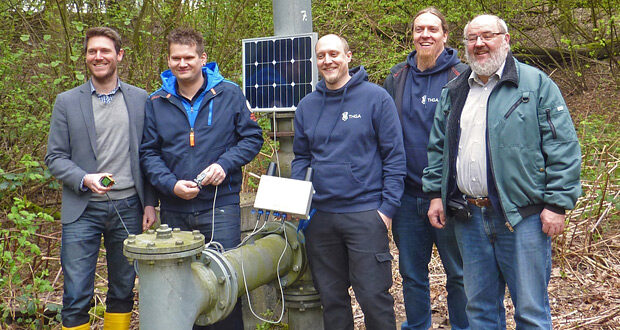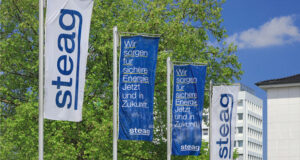RAG Aktiengesellschaft, Essen/Germany, started to digitise abandoned surface openings, shafts and mining galleries of the coal mining sector via the Sigfox-0G network. There are around 60,000 in North Rhine-Westphalia alone. The aim of this IoT connection is the continuous monitoring of changes in real time in order to increase protection against sinkholes and reduce the effort of on-site inspections. The Sigfox–0G-based mining shaft monitoring system, which is also used for long-term documentation, has been designed by the Research Center of Post-Mining (FZN) and the Electrical Engineering/Information Technology and Industrial Engineering research sector of the TH Georg Agricola University (THGA) in Bochum/Germany and developed to series production in cooperation with the RAG (Figure 1).
The 0G-based remote monitoring system which is operated by a solar generator comprises pull-wire switches and a microcontroller with radio transceiver, which transfers the data via Sigfox-0G networks to a monitoring cloud. The sensors monitor, e. g., the vertical movement of the filling column of an old mine shaft. The data collected via Sigfox-0G network can be shown in the cloud for monitoring purposes and in the event of an alarm can be automatically sent to a predefined message chain by SMS and e-mail.
“It is necessary to constantly monitor the over 5,200 km2 hard coal easements in our area of responsibility which have around 7,200 former surface openings because sinkholes are possible at any time in a section of around 100 km2. Therefore, around 6,000 inspections are carried out every year in order to be able to take preventative action in good time. To minimise these on-site inspections and for real-time monitoring of any changes, selected surface openings are now also constantly monitored via a Sigfox-0G network connection”, says Frank Wollnik from the Site and Geo Services Division of RAG.
“The Sigfox-0G solution for shaft monitoring is an element of the so-called Mineberry system, which works completely independently and is solar-operated and is suitable for almost every type of old mining objects thanks to the modular structure. In order to implement the cloud connection of our remote monitoring solution in a manner that is cost-efficient, long-lasting and maintenance-free, we connected proven sensor technology to the innovative Sigfox-0G network. And as it can be used worldwide without any roaming charges, our solution can also be used worldwide”, explains Prof. Bernd vom Berg, Head of the Laboratory for Electrical Measurement and the Laboratory for Microprocessor Technology at the THGA.
“The RAG monitoring system is an excellent example of the remote monitoring of things and states, which up to now could not always be given special attention because it was too expensive or too energy-hungry to record all this data in real time. However, with Sigfox 0G real-time monitoring of even the simplest objects and states is possible. In the case of mining, it is easy to imagine that there are many control points worldwide, which can be monitored via a Sigfox-0G network. Especially because after the fossil-fuel phase-out no more money is earned, cost-efficient and low-maintenance data communication channels like Sigfox-0G offers are particularly important”, explains Stéphane Pâris, Technical and Network Director at Sigfox Germany.
The 0G controller is installed aboveground outside the possible Ex zone for the remote monitoring system for surface opening monitoring, whereas the Ex-protected sensors are installed in the shaft. As radio signals can be transmitted via the Sigfox-0G network across many kilometres, their use is also possible in areas with a poor mobile phone connection. The controllers can also be operated for many years without changing the batteries thanks to the battery-saving radio technology. Installations in the equally radio-critical underground environment can be found in the water supply network of the city of Antwerp. However, prerequisites for extensive underground installations are repeaters, which must be positioned every 3 to 5 km. (THGA/Si.)



